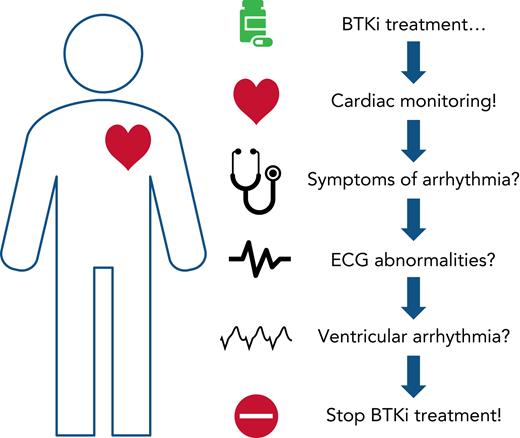In this issue of Blood, Bhat et al systematically evaluated the rate of incident symptomatic ventricular arrhythmias (VAs) in a large case series of patients treated with acalabrutinib.1 Although the observed cardiotoxic adverse events in nearly 3% of patients treated with acalabrutinib was lower than that reported in patients treated with ibrutinib, the percentage was eightfold higher than that in similar untreated control patients. These data indicate that VAs may be a class-specific effect of Bruton tyrosine kinase inhibitors (BTKi’s).
The BTKi ibrutinib was approved by the US Food and Drug Administration for treating B-cell lymphoproliferative disorders almost 10 years ago. Just recently, the second-generation BTKi acalabrutinib was granted approval for treating chronic lymphocytic leukemia (CLL).
Cardiac toxicity is a recognized treatment-limiting adverse effect of BTKi’s. The mechanism of this toxicity is hypothesized to be on-target inhibition of BTK and related kinases such as tec protein kinase, which results in reduced PI3K-Akt activity in cardiac cells thus decreasing its cardioprotective role under conditions of stress.2
The most common cardiac toxicity is atrial fibrillation, which might lead to subsequent use of anticoagulation therapy to reduce the risk of thromboembolism. Because BTKi’s selectively also inhibit platelet signaling and function downstream of the collagen receptor glycoprotein VI,3 their use is associated with an increased risk of bleeding, which usually manifests as minor bruising. However, concomitant use of anticoagulants significantly increases the risk for major hemorrhage.4 In clinical practice, the onset of atrial fibrillation often mandates that treatment with BTKi’s be terminated because of the increased risk of bleeding.
In clinical trials, ibrutinib (a first-generation BTKi) led to cardiac arrhythmias in up to 20% of patients,5 including 12% of patients with atrial fibrillation, compared with 8% of patients with cardiac arrhythmias and 1.2% of patients with atrial fibrillation in the untreated population. With longer follow-up, case series of VAs and sudden cardiac deaths that have been described in patients treated with ibrutinib6,7 further raises awareness of the potential for severe cardiotoxicity.
Second-generation BTKi’s demonstrate greater BTK selectivity and less off-target inhibition compared with ibrutinib. The first direct comparison of the more selective acalabrutinib vs the less selective ibrutinib demonstrated noninferior progression-free survival with fewer cardiovascular events. The adverse event of atrial fibrillation was prospectively assessed as a secondary end point and was significantly lower in the acalabrutinib treatment arm than in the ibrutinib arm (9% vs 15.6%, respectively).8 The first pooled analysis of patients treated with acalabrutinib reported cardiac adverse events in 17%, with atrial fibrillation the most common cardiac adverse effect in 5% of all patients.9 However, no cases of VA were reported for patients treated with acalabrutinib.
Bhat et al provide the first evidence of an increased risk for VAs in patients treated with the second-generation BTKi acalabrutinib. Although the frequency of this severe cardiotoxicity was less common than with ibrutinib, the data strongly indicate that there is a cardiotoxicity class effect with BTKi therapies. In clinical practice, this should translate into systematic cardiac monitoring of all patients treated with BTKi’s, with careful assessment of cardiovascular risk factors and a baseline electrocardiogram before treatment is initiated. During treatment with BTKi’s, clinicians should inquire about symptoms of VA (lightheadedness, palpitations, or syncope) and perform diagnostic electrocardiograms with a low threshold (see figure). Other targeted treatment modalities may be available, so patients who develop cardiotoxicity associated with BTKi’s may be advised to discontinue treatment with them and switch to an alternative treatment regimen.
The median time to VA reported by Bhat et al was more than 1 year after treatment initiation, so a time-limited treatment regimen with a BTKi would not only prevent long-term toxicities but might also reduce the risk of severe cardiotoxicity. Therefore, a treatment regimen of fixed duration should be developed and investigated in clinical trials, with a careful assessment of long-term cardiotoxicity.
In conclusion, it is vital that patients and caregivers be aware of the severe cardiotoxicity associated with ibrutinib and also with the second-generation BTKi acalabrutinib. Consideration of cardiovascular adverse effects is an important decision-making tool for selecting treatment for CLL, even in a regimen based on acalabrutinib.
Conflict-of-interest disclosure: P.L. has received grants and other funding from Janssen-Cilag and other funding from AbbVie, AstraZeneca, and F. Hoffman-LaRoche.


This feature is available to Subscribers Only
Sign In or Create an Account Close Modal